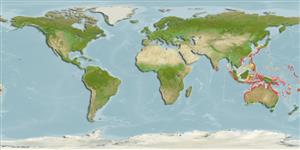>
Kurtiformes (Nurseryfishes, cardinalfishes.) >
Apogonidae (Cardinalfishes) > Apogoninae
Etymology: Siphamia: A Swazi word, siphama, for a fish.
Environment: milieu / climate zone / depth range / distribution range
Ecología
marino asociado a arrecife; rango de profundidad 1 - 18 m (Ref. 90102). Subtropical
Western Pacific: from the Ryukyu and Ogasawara islands of Japan to northwestern Australia and Queensland. Also recorded from Tonga (Ref. 90102).
Tamaño / Peso / Age
Maturity: Lm ? range ? - ? cm
Max length : 3.5 cm SL macho / no sexado; (Ref. 27362)
Espinas dorsales (total): 7; Radios blandos dorsales (total): 9-10; Espinas anales 2; Radios blandos anales: 8. This species is distinguished by the following characters: dorsal fin rays VI-I, 9; anal fin rays II, 8; pectoral fin rays 15; pelvic fin rays I, 5; pored lateral line scales 23; predorsal scales 6; circumpeduncular scales 12; total gill rakers 13-14, developed gill rakers 7-8 (Ref. 093839); body uniformly black and all fins pinkish except for pectoral. Head large. Similar to S. versicolor, but distinguished by 6 spines on the first dorsal (7 in S. versicolor). Body and weakly ctenoid scales covered with a mucous membrane. A luminous organ is present inside the translucent thorax muscles, containing symbiotic luminescent bacteria.
Commensal with sea urchins and crown of thorns starfish (Ref. 27362). Occurs in small groups, also found in sheltered reefs and adjacent sand, rubble and rocky bottoms (Ref 90102).
Life cycle and mating behavior
Madurez | Reproducción | Puesta | Huevos | Fecundidad | Larva
Distinct pairing during courtship and spawning (Ref. 205).
Gon, O. and G.R. Allen, 2012. Revision of the Indo-Pacific cardinalfish genus Siphamia (Perciformes: Apogonidae). Zootaxa 3294:1-84. (Ref. 90035)
IUCN Red List Status (Ref. 130435)
Threat to humans
Harmless
Human uses
Más información
ReferenciasAcuiculturaPerfil de acuiculturaRazasGenéticaElectrophoresesheritabilidadEnfermedadesProcesamientoNutrientsMass conversion
ColaboradoresImágenesStamps, Coins Misc.SonidosCiguateraVelocidadTipo de nataciónSuperficie branquialOtolitosCerebrosVisión
Herramientas
Special reports
Download XML
Fuentes de Internet
Estimates based on models
Preferred temperature (Ref.
123201): 24.7 - 29.3, mean 28.5 °C (based on 1932 cells).
Phylogenetic diversity index (Ref.
82804): PD
50 = 0.5000 [Uniqueness, from 0.5 = low to 2.0 = high].
Bayesian length-weight: a=0.01479 (0.00690 - 0.03171), b=3.09 (2.91 - 3.27), in cm total length, based on LWR estimates for this (Sub)family-body shape (Ref.
93245).
Nivel trófico (Ref.
69278): 3.2 ±0.5 se; based on size and trophs of closest relatives
Resiliencia (Ref.
120179): Alto, población duplicada en un tiempo mínimo inferior a 15 meses (Preliminary K or Fecundity.).
Fishing Vulnerability (Ref.
59153): Low vulnerability (10 of 100).
Nutrients (Ref.
124155): Calcium = 244 [86, 781] mg/100g; Iron = 1.93 [0.78, 4.74] mg/100g; Protein = 19.1 [17.3, 20.8] %; Omega3 = 0.198 [0.057, 0.699] g/100g; Selenium = 20 [5, 74] μg/100g; VitaminA = 26.2 [3.9, 213.2] μg/100g; Zinc = 2.47 [1.13, 4.78] mg/100g (wet weight);
